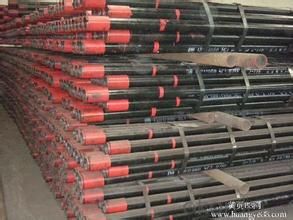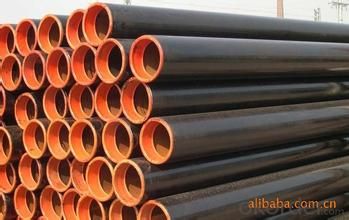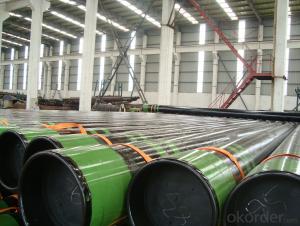Seamless Casing Steel Pipe 2
- Loading Port:
- China Main Port
- Payment Terms:
- TT or LC
- Min Order Qty:
- -
- Supply Capability:
- -
OKorder Service Pledge
OKorder Financial Service
You Might Also Like
1. Seamless Casing Steel Pipe Specifications
1) Grade:H-40,J-55,K-55,N-80,C-75,L-80,C-90,C-95,P-110,Q-125
2) Size: 4 1/2", 5", 5 1/2", 6 5/8", 7", 7 5/8", 9 5/8", 10 3/4", 13 3/8", 16", 18 5/8", 20"
3) Wall thickness: 5.11 - 16.13 mm
4) Clasp Type : STC, LTC, BTC
5) Length : R1,R2,R3
6) Products comply with API SPEC 5CT standards, and use for API 5CT emblem
2. Round thread casing coupling size quality and tolerance:
Code | Specification | Diameter W /mm | Min Length | Boring diameter /mm | Width of bearing surferingb/mm | Weight | ||
Diameter D /mm | Short coupling Nl | Coupling length Nl | short couping | Coupling length | ||||
4-1/2 | 114.30 | 127.00 | 158.75 | 177.80 | 116.68 | 3.97 | 3.62 | 4.15 |
5 | 127.00 | 141.30 | 165.10 | 196.85 | 129.38 | 4.76 | 4.66 | 5.75 |
5-1/2 | 139.70 | 153.67 | 171.45 | 203.20 | 142.08 | 3.18 | 5.23 | 6.42 |
6-5/8 | 168.26 | 187.71 | 184.15 | 222.25 | 170.66 | 6.35 | 9.12 | 11.34 |
7 | 177.80 | 194.46 | 184.15 | 228.60 | 180.18 | 4.76 | 8.39 | 10.83 |
7-5/8 | 193.70 | 215.90 | 190.50 | 234.95 | 197.64 | 5.56 | 12.30 | 15.63 |
8-5/8 | 219.08 | 244.48 | 196.85 | 254.00 | 223.04 | 6.35 | 16.23 | 21.67 |
9-5/8 | 244.48 | 269.88 | 196.85 | 266.70 | 248.44 | 6.35 | 18.03 | 25.45 |
10-3/4 | 273.05 | 298.45 | 203.20 | --- | 277.02 | 6.35 | 20.78 | --- |
11-3/4 | 298.45 | 323.85 | 203.20 | --- | 302.42 | 6.35 | 22.64 | --- |
13-3/8 | 339.72 | 365.12 | 203.20 | --- | 343.69 | 5.56 | 25.66 | --- |
Chemical composition:
Standard codes | Models of steel tubes | Chemical compositions | ||||||||||
C | Si | Mn | P | S | Cr | Ni | Cu | Mo | V | Als | ||
API SPEC 5CT | J55K55 | 0.340.39 | 0.200.35 | 1.251.50 | ≤0.020 | ≤0.015 | ≤0.15 | ≤0.20 | ≤0.20 | ≤0.020 | ||
N80 | 0.340.38 | 0.200.35 | 1.451.70 | ≤0.020 | ≤0.015 | ≤0.15 | 0.110.16 | ≤0.020 | ||||
L80(13Cr) | 0.150.22 | ≤1.00 | 0.251.00 | ≤0.020 | ≤0.010 | 12.014.0 | ≤0.20 | ≤0.20 | ≤0.020 | |||
P110 | 0.260.35 | 0.170.37 | 0.400.70 | ≤0.020 | ≤0.010 | 0.801.10 | ≤0.20 | ≤0.20 | 0.150.25 | ≤0.08 | ≤0.0 | |
3. FAQ of Seamless Casing Steel Pipe:
①How is the quality of your products?
Our products are manufactured strictly according to national and internaional standard, and we take a test on every pipe before delivered out. If you want see our quality certifications and all kinds of testing report, please just ask us for it.
Guaranteed: If products’ quality don’t accord to discription as we give or the promise before you place order, we promise 100% refund.
②How about price?
Yes, we are factory and be able to give you lowest price below market one, and we have a policy that “ for saving time and absolutely honest business attitude, we quote as lowest as possible for any customer, and discount can be given according to quantity”,if you like bargain and factory price is not low enough as you think, just don’t waste your time.Please trust the quotation we would give you, it is professional one.
③Why should you chose us?
Chose happens because of quality, then price, We can give you both.Additionally, we can also offer professional products inquiry, products knowledge train(for agents), smooth goods delivery, exellent customer solution proposals.Our service formula: good quality+good price+good service=customer’s trust
SGS test is available, customer inspection before shipping is welcome, third party inspection is no problem.
Any question, pls feel free to contact us !
4、Seamless Casing Steel Pipe Images:



- Q:How do you calculate the pipe flow velocity coefficient for steel pipes?
- The pipe flow velocity coefficient for steel pipes can be calculated using the Manning's equation. Manning's equation is used to calculate the flow velocity in open channels and pipes, and it takes into account the hydraulic radius, slope, and roughness coefficient of the pipe. To calculate the pipe flow velocity coefficient for steel pipes, follow these steps: 1. Determine the hydraulic radius (R) of the steel pipe. The hydraulic radius is calculated by dividing the cross-sectional area of the pipe (A) by the wetted perimeter (P). The formula is R = A/P. 2. Find the slope (S) of the pipe. The slope represents the change in elevation divided by the length of the pipe. It is usually given as a ratio or a percentage. 3. Determine the roughness coefficient (n) of the steel pipe. The roughness coefficient represents the internal roughness of the pipe and can be obtained from literature or pipe manufacturer specifications. It is commonly given in terms of the Manning's roughness coefficient. 4. Substitute the values of hydraulic radius (R), slope (S), and roughness coefficient (n) into the Manning's equation: V = (1/n) * R^(2/3) * S^(1/2) where V is the flow velocity. 5. Solve the equation for V to calculate the pipe flow velocity coefficient for steel pipes. It is important to note that the calculated velocity coefficient may vary based on the specific pipe dimensions, flow conditions, and other factors. Therefore, it is recommended to consult relevant engineering standards or consult with a hydraulic engineer to ensure accurate and reliable calculations for specific applications.
- Q:What are the dimensions of a standard steel pipe?
- The dimensions of a standard steel pipe can vary depending on its intended use, but common dimensions include a nominal size (such as 1/2 inch, 1 inch, 2 inches, etc.) and a schedule number indicating its wall thickness (such as Schedule 40 or Schedule 80). The outside diameter of the pipe can range from small sizes of less than half an inch to large sizes of several feet. The length of a standard steel pipe is typically 21 feet, although shorter lengths are also available.
- Q:What is a tight steel tube?
- JDG pipe is the replacement of traditional PVC and SC pipes and other traditional wire conduits. It is a breakthrough in the field of building electrical field using new materials and technologies. The JDG pipe adopts the cross connecting ground wire of galvanized steel pipe and thin-wall steel pipe, overcomes the defects of complicated construction and large construction loss of common metal pipe, and solves the problems of poor fire resistance and difficult grounding of PVC pipe. Because the JDG pipe material is more expensive than the ordinary pipe material, it is more used in the construction, such as comprehensive wiring, fire protection wiring and so on.
- Q:What are the different types of corrosion that can affect steel pipes?
- There are several types of corrosion that can affect steel pipes, including general or uniform corrosion, pitting corrosion, galvanic corrosion, crevice corrosion, and stress corrosion cracking.
- Q:How do steel pipes withstand pressure?
- Steel pipes are able to withstand pressure due to their high strength and durability. The material properties of steel, including its tensile strength and resistance to deformation, allow it to withstand the internal forces caused by pressure without experiencing significant distortion or failure. Additionally, the seamless construction of steel pipes ensures that there are no weak points or joints that could compromise their ability to withstand pressure.
- Q:What are the different methods of pipe cutting for steel pipes?
- There are several methods of cutting steel pipes including manual methods such as hacksaw cutting and abrasive cutting, as well as more advanced methods like plasma cutting, laser cutting, and water jet cutting. Each method has its own advantages and is selected based on the specific requirements of the project.
- Q:Are steel pipes suitable for use in acidic environments?
- No, steel pipes are generally not suitable for use in acidic environments because they are prone to corrosion in such conditions.
- Q:What does "spiral welded steel pipe" DN325*10 mean?
- Spiral welded steel pipe with nominal diameter of 325mm and wall thickness of 10mm
- Q:What are the different methods of measuring the thickness of steel pipes?
- There are several methods of measuring the thickness of steel pipes, including ultrasonic testing, magnetic particle testing, eddy current testing, and laser scanning.
- Q:Can steel pipes be used for electrical conduits?
- No, steel pipes are not typically used for electrical conduits as they are conductive and can pose a safety risk. Electrical conduits are usually made of non-conductive materials such as PVC or metal with insulating coatings.
1. Manufacturer Overview |
|
|---|---|
| Location | |
| Year Established | |
| Annual Output Value | |
| Main Markets | |
| Company Certifications | |
2. Manufacturer Certificates |
|
|---|---|
| a) Certification Name | |
| Range | |
| Reference | |
| Validity Period | |
3. Manufacturer Capability |
|
|---|---|
| a)Trade Capacity | |
| Nearest Port | |
| Export Percentage | |
| No.of Employees in Trade Department | |
| Language Spoken: | |
| b)Factory Information | |
| Factory Size: | |
| No. of Production Lines | |
| Contract Manufacturing | |
| Product Price Range | |
Send your message to us
Seamless Casing Steel Pipe 2
- Loading Port:
- China Main Port
- Payment Terms:
- TT or LC
- Min Order Qty:
- -
- Supply Capability:
- -
OKorder Service Pledge
OKorder Financial Service
Similar products
New products
Hot products
Related keywords































